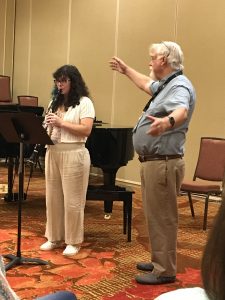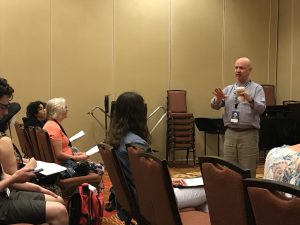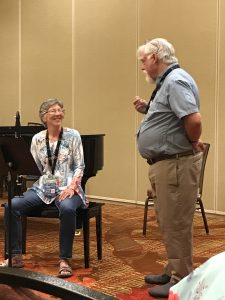
ClarinetFest® 2023 in Review
ClarinetFest® 2023 Day 4
Health and Wellness Expert Somatic Masterclass 3
by Nancy Williams

This masterclass was part of a somatic series presented at ClarinetFest® this year with Shawn Copeland, Jackie McIlwain, and Bill Conable team teaching each session. Copeland welcomed the audience and informed everyone that the words and phrases used in the session are not as important as the experience in the body. Conable announced the format of 3 performers working with a team member for 20 minutes each. He prepared the performers to expect little performance time of their prepared material, but rather more of a systemic, general coaching approach to a sample of their work.
The first performer was a professional bass clarinetist who has been experiencing tension in the back and shoulders. Copeland invited us all to sit like they were playing bass clarinet and instructed everyone on how to sit for optimum health, which he later referred to as neutral position. After this initial position was established, he instructed the clarinetist to plant the bass clarinet and bring it to the body, as opposed to moving the body to reach the instrument. The coaching continued with the performer experimenting with new instruction and then providing feedback on the experience.

Copeland stressed that it was important to feel free to move, but to come back to neutral position to release physical tension. He related this tension to tension in music, something that occurs naturally but also resolves. To encourage the release of tension, performers must relax and return to neutral at the end of each phrase. Copeland cautioned that if movement is discouraged, students often overcompensate and will try to keep from moving at all, and that is not a healthy solution. Additionally, pain should not be used as an indicator to stop playing. Clarinetists should stop and rest before the pain occurs.
The second performer was a soprano clarinet enthusiast who was coached by Conable. The coaching emphasized changing an immobile point of reading music to a mobile, wider view of the room, with Conable at one point turning the music stand around and removing the music entirely. He asked the clarinetist to describe elements of the ceiling, floor, and walls to facilitate this more encompassing view. Throughout this coaching and the next, Conable used the same process as Copeland of introducing new ideas and having the performer synthesize them through playing, then asking for feedback about the experience. Conable summarized the coaching by emphasizing the importance of giving students the opportunity to experience things in a different way.

Conable focused on noticing a larger space in the mind and body so that playing is part of a bigger context with the third and final performer, an undergraduate student playing soprano clarinet. Instructions included breathing normally and paying attention to where the breath was felt within the body. This should include space between the hips, shoulders, and mid-back. Clarinetists can then feel like they are resetting their body with each breath, noticing the entire space in the body as opposed to only the front.
The masterclass was concluded with information about a workshop at the end of the month and the invitation to sign up for a free private lesson with each of the 3 presenters (also members of the musician wellness business mBODYed) while at ClarinetFest®.
Comments are closed.